2022年中考英语 考点专项突破课件: 第二章 第九节 动词(共81张PPT)
文档属性
| 名称 | 2022年中考英语 考点专项突破课件: 第二章 第九节 动词(共81张PPT) | 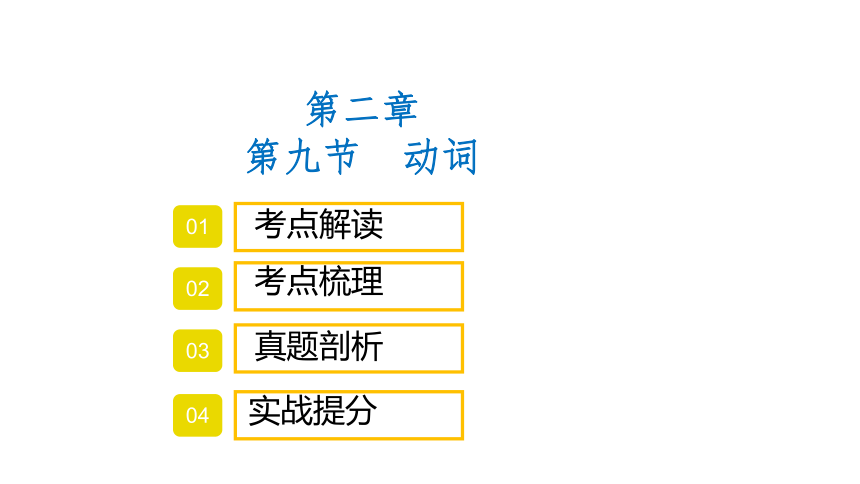 | |
| 格式 | pptx | ||
| 文件大小 | 533.5KB | ||
| 资源类型 | 教案 | ||
| 版本资源 | 牛津译林版 | ||
| 科目 | 英语 | ||
| 更新时间 | 2022-05-11 22:34:53 | ||
图片预览


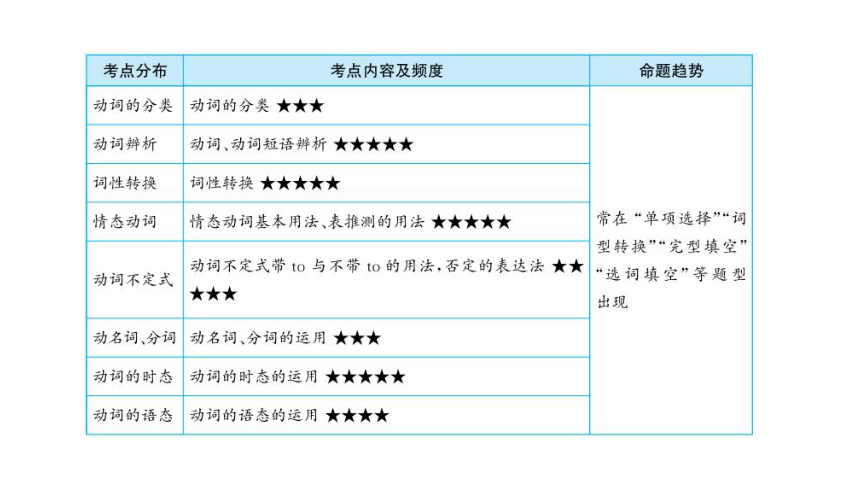



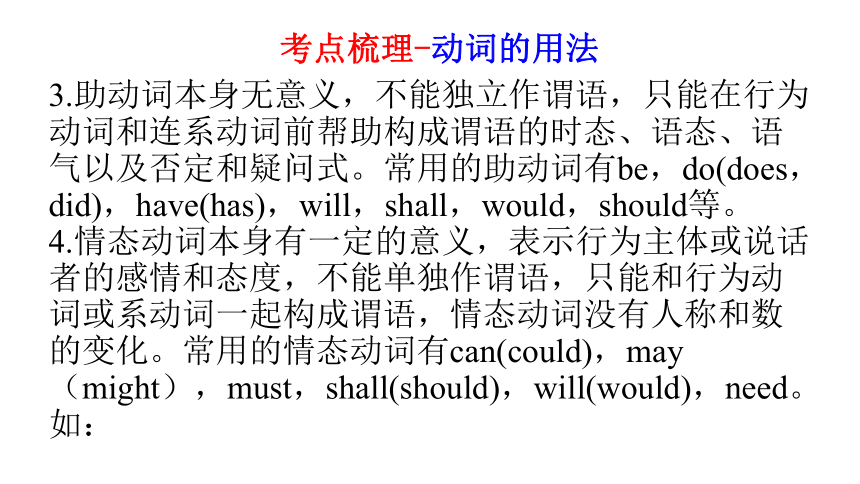
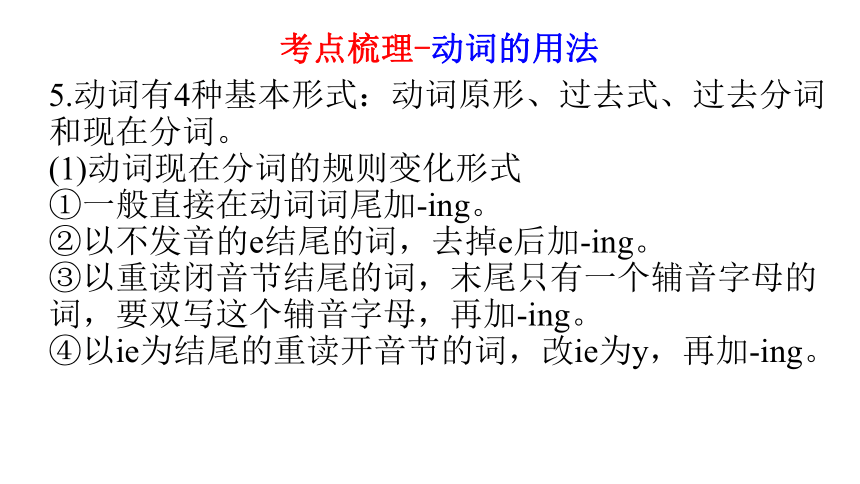
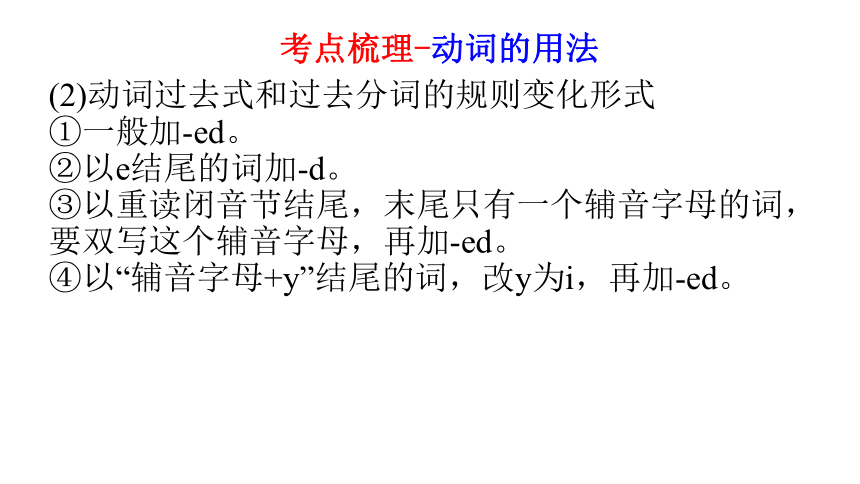
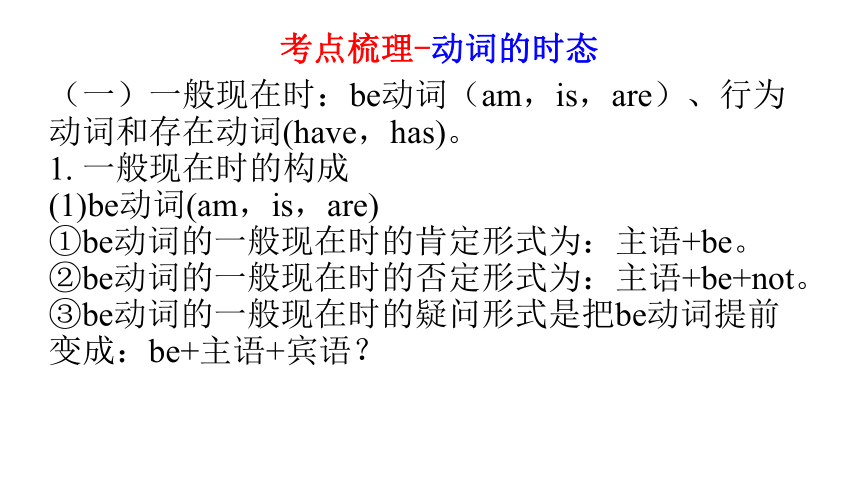

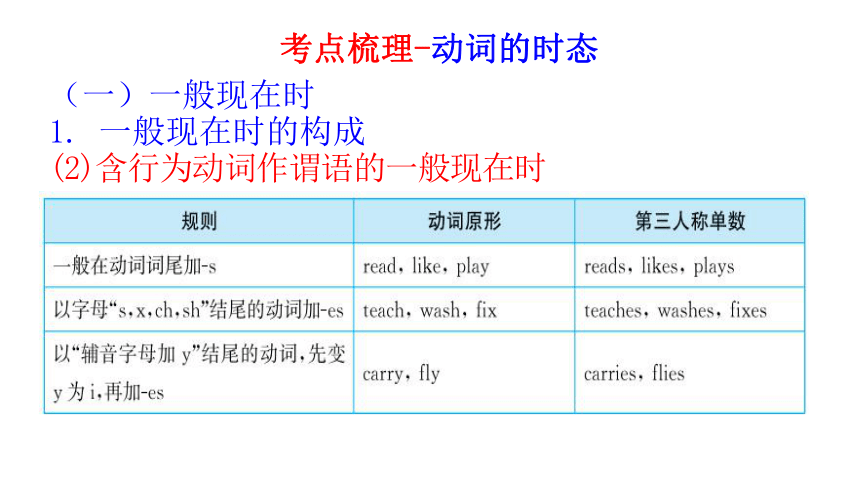
文档简介
(共81张PPT)
01
考点解读
02
03
04
考点梳理
真题剖析
实战提分
第二章
第九节 动词
01
考点解读
02
考点梳理
考点梳理-动词的用法
考点梳理-动词的用法
1.行为动词分及物和不及物动词两种,若是及物动词,其后须接宾语,不及物动词后面不能接宾语。不少动词既是及物动词又是不及物动词。
2.连系动词不能独立作谓语,要和表语一起构成谓语。常用的连系动词有be,become,feel,get,keep,look,smell,sound,seem,stay,taste,turn等。连系动词除be和become等少数词可接名词作表语外,一般都接形容词。
考点梳理-动词的用法
3.助动词本身无意义,不能独立作谓语,只能在行为动词和连系动词前帮助构成谓语的时态、语态、语气以及否定和疑问式。常用的助动词有be,do(does,did),have(has),will,shall,would,should等。
4.情态动词本身有一定的意义,表示行为主体或说话者的感情和态度,不能单独作谓语,只能和行为动词或系动词一起构成谓语,情态动词没有人称和数的变化。常用的情态动词有can(could),may(might),must,shall(should),will(would),need。如:
考点梳理-动词的用法
5.动词有4种基本形式:动词原形、过去式、过去分词和现在分词。
(1)动词现在分词的规则变化形式
①一般直接在动词词尾加-ing。
②以不发音的e结尾的词,去掉e后加-ing。
③以重读闭音节结尾的词,末尾只有一个辅音字母的词,要双写这个辅音字母,再加-ing。
④以ie为结尾的重读开音节的词,改ie为y,再加-ing。
考点梳理-动词的用法
(2)动词过去式和过去分词的规则变化形式
①一般加-ed。
②以e结尾的词加-d。
③以重读闭音节结尾,末尾只有一个辅音字母的词,要双写这个辅音字母,再加-ed。
④以“辅音字母+y”结尾的词,改y为i,再加-ed。
考点梳理-动词的时态
(一)一般现在时:be动词(am,is,are)、行为动词和存在动词(have,has)。
1. 一般现在时的构成
(1)be动词(am,is,are)
①be动词的一般现在时的肯定形式为:主语+be。
②be动词的一般现在时的否定形式为:主语+be+not。③be动词的一般现在时的疑问形式是把be动词提前变成:be+主语+宾语?
考点梳理-动词的时态
(一)一般现在时
1. 一般现在时的构成
(2)含行为动词作谓语的一般现在时
①含行为动词谓语的一般现在时的肯定形式为:主语+动词。
②含行为动词作谓语的一般现在时的否定形式为: do not/don't/does not/doesn't+动词原形。
③含行为动词作谓语的一般现在时的疑问形式要用助动词来提问,而且要用助动词来回答。
考点梳理-动词的时态
(一)一般现在时
1. 一般现在时的构成
(2)含行为动词作谓语的一般现在时
考点梳理-动词的时态
(一)一般现在时
2. 一般现在时的用法
(1)表示经常或习惯性的动作或存在的状态,常与often,usually,always,sometimes,every day等时间状语连用。
(2)表示现在的特征或状态。
(3)表示客观规律、事实或科学真理。
(4)用于谈论时间表、旅程表、籍贯、国籍。
(5)用于时间状语和条件状语从句中表示将来。
(6)表示主语具备的性格、特征和能力。
考点梳理-动词的时态
(二)一般过去时
1. 一般过去时的定义
一般过去时表示过去发生的动作或存在的状态,常与yesterday,just now,last week,two days ago,in 1988等表示过去的时间状语连用。一般过去时用动词的过去式表示,动词的过去式除be动词有人称、数的区别外,其余动词都没有人称、数的区别。
考点梳理-动词的时态
(二)一般过去时
2. 一般过去时的构成
(1)肯定形式:为“主语+be动词的过去式(was,were)”或“主语+行为动词的过去式”。
(2)否定形式:含有be动词的一般过去时的否定形式直接在be动词之后加not, 含有行为动词的要用“助动词did +not+动词原形”的形式。
(3)疑问形式:含有be动词的一般过去时的疑问形式要将be(was,were)动词提前;含有行为动词的要将助动词did提前,构成“did+主语+动词原形?”的形式
考点梳理-动词的时态
(二)一般过去时
3. 一般过去时的用法
(1)表示过去未指明具体时间的动作。
(2)表示在过去特定的时间结束的动作。
(3)表示过去某一段时间内经常反复或习惯性的动作。
(4)表示过去常常或反复发生的动作,也可以用“used to+动词原形”或“would+动词原形”形式。
考点梳理-动词的时态
(三)一般将来时
1. 一般将来时的构成
一般将来时由“助动词will +动词原形”构成,在书面语中,主语为I和we时,常用“助动词shall+动词原形”的形式。
考点梳理-动词的时态
(三)一般将来时
2. 一般将来时的用法
(1)表示将要发生的动作或存在的状态。
(2)表示将来经常或反复发生的动作。
(3)将来时态的其他表示方法
①“be going to+动词原形”,表示即将发生,或打算、计划、决定要做的事,或可能要发生的事
②有些表示位置移动的动词(如come,go,leave,return等),可用现在进行时表示按计划即将进行的动作。③某些动词(如come,go,leave,start等)的一般现在时形式可表示计划或将要发生的动作④“be+动词不定式”表示安排了要在将来做的事。
考点梳理-动词的时态
(四)现在进行时
1. 现在进行时的构成
现在进行时用来描述正在进行的动作,是由“助动词be的现在式(am,is,are)+现在分词”构成。
考点梳理-动词的时态
(四)现在进行时
1. 现在进行时的构成
(1)肯定形式:由“主语+be动词(am,is,are)+动词的现在分词”构成。
(2)否定形式:是由“主语+be动词(am,is,are) +not+动词的现在分词”构成。
(3)疑问形式:是把be动词提前,即由“be动词+主语+动词的现在分词”构成。
考点梳理-动词的时态
(四)现在进行时
2. 现在进行时的用法
(1)表示此时此刻正在进行或发生的动作。
(2)表示当前一段时间内的活动或现阶段正在进行的动作,但说话时不一定正在进行。
(3)表示将来的动作。
(4)表示“逐渐;越来越……”。
考点梳理-动词的时态
(五)现在完成时
1. 现在完成时的构成
现在完成时表示一个始于过去但现在已经完成的动作或状态。并对现在产生影响,是由“主语+助动词have/has+动词的过去分词”构成。
(1)肯定形式:主语+助动词have/has+动词的过去分词。
(2)否定形式:主语+助动词have/has+not+动词的过去分词。
(3)疑问形式:要把have/has提前,即Have/Has+主语+动词的过去分词+其他?
考点梳理-动词的时态
(五)现在完成时
2. 现在完成时的用法
(1)表示过去发生的某一行为对现在造成的影响或结果。
(2)表示过去已经发生,持续到现在的动作或状态,常与since、for引导的表示一段时间的状语连用,或用于“How long”句型中。
【注意】 for+时间段;since+时间点。
(3)表示从过去某一时间到说话时这一过程中动作发生次数的总和。
(4)表示从过去某一时间到说话时这段时间中反复发生的动作,常与often、always、seldom、never等副词连用。
考点梳理-动词的时态
(五)现在完成时
3. 常与现在完成时连用的时间状语
现在完成时常与表示从某时刻延续到现在,并包括现在在内的一段时间状语连用,如recently(最近),lately(近来),so far(至今),up to now(至今),today,this morning, this week, in the past few months(过去的几个月里),already,yet,never,ever,just等。
考点梳理-动词的时态
(六)过去进行时
1. 过去进行时的构成
过去进行时表示过去一段时间里一直进行的动作,由“was/were+现在分词”构成。
(1)肯定形式:主语+was/were+现在分词。
(2)否定形式:主语+was/were+not+现在分词。
(3)疑问形式:was/were+主语+现在分词。
考点梳理-动词的语态
(一)被动语态的构成
被动语态由“助动词be+过去分词”构成,其时态变化通过be的各种时态形式表现出来。被动语态的时态在初中学习中较常见的有3种。
考点梳理-动词的语态
(二)被动语态的用法
1. 不知道或没有必要指出谁是动作的执行者时
2. 当更加强调动作的承受者时。此时动作的执行者由by引导置于谓语动词之后,不需要时可以省略。
3. 当动作的执行者不是人时,多用被动语态。
4. 表示客观的说明常用“It is+过去分词”的句型。
考点梳理-动词的语态
(三)主动语态和被动语态的转换
1. 转换示意图
考点梳理-动词的语态
(三)主动语态和被动语态的转换
2. 含有情态动词的被动语态
带情态动词的被动结构的固定式为“情态动词+be+过去分词”,也有个别带“to”的情态动词例外,如ought to和have to,它们的被动结构就只能在不定式中。
考点梳理-助动词和情态动词
(一)助动词
助动词本身没有意义,不能单独作谓语。它常配合主要动词,协助构成否定句、疑问句、强调句、时态、语态等语法形式。
常见的助动词有: be(无词义),do/does/did(无词义),have/has/had(无词义),shall将要,will将要。
考点梳理-助动词和情态动词
(一)助动词
1. be的助动词用法:be作为助动词,用来构成进行时态和被动语态。
2. do的助动词用法:do作为助动词,用来构成疑问句、否定句、强调句。
3. have的助动词用法:have作为助动词,用来构成完成时态。
4. shall和will的助动词用法:shall和will作为助动词,用来构成将来时态。
考点梳理-助动词和情态动词
(二)情态动词
1. 情态动词的定义和语法特征
情态动词是一种本身有一定的词义,表示说话人的情绪、态度或语气的动词,但不能单独作谓语,只能和其他动词原形构成谓语。
情态动词的语法特征:
(1)情态动词表示期待或估计某事的发生。
(2)情态动词没有人称、数的变化,后接动词原形。
情态动词主要有: can (could), may (might),must, need, dare, ought to, have to, shall (should), will (would)。
考点梳理-助动词和情态动词
(二)情态动词
2. 情态动词的位置
情态动词在肯定句、否定句中,放在主语之后;在疑问句中,情态动词则放在主语之前。
3. 情态动词的具体用法
(1) can,could表示说话人能、可以、同意、准许以及客观条件许可,could为can的过去式。could还可表示提出委婉的请求。(2) may,might可以。表示说话人同意、许可或请求对方许可。(3) must必须,应该,一定,准是。表示说话人认为有必要做某事,或表示命令、要求别人做某事以及对事物的推测。(4) need需要。多用于否定式或疑问句中。例如:
考点梳理-非谓语动词
(一)动词不定式
1. 作主语 谓语动词要用第三人称单数,常用句型:It's+adj.+(for/of)sb. +to do sth.
2. 作表语 常用于系动词be之后构成系表结构。
3. 作宾语 常见后接动词不定式作宾语的动词。如:
hope/wish to do would like/want to do prefer to do
learn to do like to do expect to do
plan to do promise to do decide to do begin/start to do try to do continue to do
agree to do refuse to do afford to do pretend to do
考点梳理-非谓语动词
(一)动词不定式
4. 作宾语补足语
(1)常见后接动词不定式作宾语补足语的动词,如:
tell sb. to do ask sb. to do
want sb. to do advise sb. to do
teach sb. to do persuade sb. to do
invite sb. to do allow sb. to do
wish sb. to do expect sb. to do
考点梳理-非谓语动词
(一)动词不定式
4. 作宾语补足语
(2)还有一些使役动词和感官动词也用不定式作宾语,这时不定式要省略to。这些动词有:一感(feel)、二听(hear, listen to)、三让 (let, make, have)、四看(look at, see, watch, notice)。但变被动语态时必须要加上to。
考点梳理-非谓语动词
(一)动词不定式
5. 作状语
(1)常见不带to的动词不定式的固定短语与句型,如:
had better (not) do... would rather do ...
prefer to do... rather than do...
Why not do... =Why don't you do...
Could/Would/Will you/Will you please (not)do...
(2)在find,think后跟不定式作宾语时,常用it代替,而将真正的宾语放在后面。
考点梳理-非谓语动词
(一)动词不定式
5. 作状语
(3)动词不定式的特殊句型
◆too...to...表示“太……而不能……”。
◆enough to...表示“……足够……”。
疑问词+动词不定式。
动词不定式可以用在疑问句what,how,when,where,which等之后,作主语、宾语、宾语补足语等。
考点梳理-非谓语动词
(二)动名词
1. 作主语
(1)动名词作主语时,谓语动词用第三人称单数形式。(2)如果并列的动名词(短语)作主语,谓语动词用复数形式。
2. 作表语 动名词(短语)作表语时,可以转化为动名词(短语)作主语。
3. 作定语 动名词(短语)作定语,表明它所修饰的词的用途、所属关系等,置于所修饰词之前。
考点梳理-非谓语动词
(二)动名词
4. 作宾语
完成实践值得忙 (finish,practice,be worth,be
busy)
继续习惯别放弃 (keep on, be used to, give up)
考虑建议不禁想 (consider, suggest,can't help,
feel like)
喜欢思念要介意 (enjoy,miss,mind)
考点梳理-非谓语动词
(二)动名词
4. 作宾语
既可接动名词又可接不定式的词
stop doing sth. stop to do sth.
try doing sth. try to do sth.
forget doing sth. forget to do sth.
remember doing sth. remember to do sth.
need doing sth. need to do sth.
03
真题剖析
真题链接-动词的用法
【例1】—How about the young lady
—It's hard to say, but her voice____beautiful.
A. sings B.hears C.listens D.sounds
【解析】本题考查行为动词与连系动词的用法区别。sing,hear,listen都是行为动词,sound是连系动词,意思为“听起来……”。行为动词可被副词修饰,而连系动词要接表语(形容词)。故答案选D。
【例2】There ____a football match on TV this evening.
A. will have B. is going to be
C. has D. in going to have
【解析】本题考查there be与have的用法区别:there be表示某时、某地有某物:have表示拥有、占有、所有。当句首出现there时,不能用have。本句中的is going to是表示将来的助动词结构。故答案选B。
真题链接-动词的用法
【例4】Sarah, you'd better drink more water after _____ for such a long time.
A. run B. runs C. to run D. running
【解析】本题考查非谓语动词的用法。after是介词,其后所跟的动词要用“ing”的形式。故答案选D。
真题链接-动词的用法
【例1】—Well, I found this.I think it must be yours.
—My watch! Thank you. Where_____it
A. do you find B. have you found
C. were you finding D. did you find
【解析】本题考查不同时态的用法区别。A一般现在时表示现阶段经常性或习惯性的动作;B现在完成时则表示过去的动作对现在的影响:C过去进行时表示过去某时正在发生或进行的动作;D一般过去时表示过去发生的动作,只说明动作发生在过去这一事实。根据句子意思答案选D。
真题链接-动词的时态
【例4】—Liu Mei can't come tonight.
—Why She_____me she would come.
A. tells B. told
C. is told D. had told
【解析】宾语从句的主从句在语法上有着相互影响、相互限制的功能。本题中,宾语从句是过去将来时,它表示在过去看来将要发生的动作,而这一“过去”时间是通过上文(即主句)来表示的。故答案选B。
真题链接-动词的时态
【例2】The lights must_____ before you do eye exercises.
A. turn on B. turn off
C. be turning on D. be turned off
【解析】本题考查含有情态动词的被动语态。含有情态动词的被动语态的结构是:情态动词+be+及物动词的过去分词。故答案选D。
真题链接-动词的语态
【例5】—Your city looks beautiful!
—Yes. Lots of trees and flowers _____last year.
A. are planted B. have planted
C. were planting D. were planted
【解析】表示主语是动作的承受者,用被动语态(be+及物动词的过去分词)。被动语态的时态是用助动词be的时态来表示的。last year是典型的过去时间状语,因此本题应用一般过去时的被动语态,故答案选D。
真题链接-动词的语态
【例】Jay Chou is a popular singer and his CDs___ well.
A. sell B. are sold C. sells
【解析】这是动词语态的易错点,主动表被动用法。本题考查主动表被动的用法。句意为:周杰伦是个很受欢迎的歌手,他的唱片卖得很好。分析句子结构可知,空前主语为物(CDs),因此用被动语态;且所需动词sell“卖;销售”是不及物动词,一般用主动形式表示被动含义;结合主语是复数形式,谓语也需用复数形式可知选A。
易错剖析-动词的语态
【例2】Boys, you______be sitting in this room. It is for your teachers only.
A. shouldn't B. don't have to
C. won't D. needn't
【解析】 should意思为“应该”;have to意思为“必须,不得不”;will意思为“将,会”; need意思为“需要”,故答案选A。
真题链接-助动词和情态动词
【例5】The man in the office_____be Mr. Black because he phoned me from London just now.
A. mustn't B. may not
C. can't D. needn't
【解析】在表示推测时,可以用may(也许、可能)或must(一定),而在表示否定推测时,常用can't表示“不可能”。根据题意,答案应选C。
真题链接-助动词和情态动词
【例1】—Can I swim here
—I'm sorry. Children______swim alone here.
A. may not B. mustn't C. needn't
【解析】 由may/can引出的一般疑问句,肯定回答用may或 can,否定回答用mustn't/can't/had better not。本题意是: —我可以在这里游泳吗?
—不好意思,儿童禁止单独在此游泳。此题用can来问,may not是“不可以”,mustn't 是“禁止”,needn't是“不必”,所以答案B是正确的
易错剖析-助动词和情态动词
【例2】—Doctors always work day and night people's _______ lives.
—How great they are!
A. save B. to save C. saving D. saved
【解析】 考查动词不定式作目的状语。句意为“医生总是日夜工作来挽救人们的生命。”“他们真的太伟大了!”分析句意可知医生日夜工作的目的是挽救人们的生命,空格处用不定式作目的状语,故选B。
真题链接-非谓语动词
【例4】Why not_____going to Sanniang Bay by boat for a change
A. to try B. trying C. tried D. try
【解析】考查非谓语动词。句意为:为什么不改变一
下,坐船去三娘湾呢? to try 动词不定式;trying动名词或现在分词;tried动词过去式或过去分词;try动词原形。Why not后面接省略to的不定式,故选D。
真题链接-非谓语动词
04
实战提分
基础过关-动词的用法
(一)按要求写出下列各词的相应形式。
原形 第三人称单数 过去式 过去分词 现在分词
1. do ________ ________ ________ ________
2. read ________ ________ ________ ________
3. stop ________ ________ ________ ________
4. die ________ ________ ________ ________
5. like ________ ________ ________ ________
6. wash ________ ________ ________ ________
does
did
done
doing
reads
read
read
reading
stops
stopped
stopped
stopping
dies
died
died
dying
likes
liked
liked
liking
washes
washed
washed
washing
基础过关-动词的用法
(二)按要求写出下列各词的相应形式。
1. play ________ (n.)
2. agree _____________ (n.)
3. collect____________ (n.)
4. die ________ (n.)
5. enjoy ________________ (adj.)
6. interest______________________________(adj.)
7. act _____________ (adj.)
8. surprise________________(adj.)
player
agreement
collection
death
enjoyable
interesting/interested
active
surprised
拓展提升-动词的用法
(一)用所给词的适当形式填空。
1.(2019年广西北部湾经济区)In the playground,I threw the ball to her and she________ (catch)it.
2.(2020年百色)________ (hurry) up! We need to finish our homework in time.
3.(2021年百色)We must________ (deal) with the rubbish correctly so that we can reuse it better.
4.Chinese Women's Football Team________ (play) in the coming Tokyo Olympics.
5.I want to think about it a bit longer before I make a________ (decide).
caught
hurry
deal
will play
decision
拓展提升-动词的用法
(一)用所给词的适当形式填空。
1.(2021年河池)There _____a concert in our school hall next week.
A. is B. was C. will be D. will have
11.(2019年徐州)Hello,Joe. I didn't _____to see you today. I thought you were away on holiday.
A. want B. prepare C. expect D. agree
14. He used to_____in a small village,but now he has been used to_____in a big city.
A. live; living B. live; live
C. living; living D. lives; lives
基础过关-动词的时态
按要求写出相应的词。
1. play________(第三人称单数)
2. fly ________(第三人称单数)
3. be ________(过去分词)
4. are ________(过去式)
5. make________(现在分词)
6. tie ________(现在分词)
7. cut ________(现在分词)
8. tell________(过去分词)
plays
flies
been
were
made
tying
cutting
told
拓展提升-动词的时态
单项选择。
1. (2020年北京)I_____on the computer when Frank called me last night.
A. work B. will work
C. was working D. am working
2. (2020年北京)—What’s that noise, Sam
—My little brother_____with his toy car now.
A. will play B. is playing
C. plays D. played
拓展提升-动词的时态
单项选择。
3. (2020年福建)Han Mei, a good friend of mine, _____me a lot with my English in the past three years.
A. helps B. helped C. has helped
4. (2020年柳州)Mr. Smith_____a novel last year but I don't know whether he has finished it.
A. wrote B. was writing C. has written
5. (2020年扬州)Yesterday Mom_____me some money to buy a dictionary.
A. gives B. gave C. has given D.was giving
拓展提升-动词的时态
单项选择。
6. (2020年河北)It_____dark. Shall I turn on the light
A.gets B.got C.is getting D.was getting
7. (2020年重庆) Listen! Our teacher_____in the music classroom.
A. sings B. sang C. will sing D.is singing
8. (2020年长沙)—What happened to Mrs. Smart
—She _____cut herself while she lunch.
A. prepares B. is preparing C.was preparing
基础过关-动词的语态
用所给单词的正确形式填空。
1. Teenagers should be _________(allow) to make their own decisions.
2. The classroom must____________(clean) every day.
3. The chicken_________(taste) good.
4. The class meeting will_________(hold) this afternoon.
5. The birthday card___________(make) yesterday morning.
allowed
be cleaned
tastes
be held
was made
拓展提升-动词的语态
单项选择。
1.(2020年天津)That machine is broken.It_____tomorrow.
A. repaired B. was repaired
C. will repair D. will be repaired
2. (2020年武汉)—Do you need any help
—No, thanks. We_____a lot of support since last year.
A. have offered B. have been offered
C. were offered D. were offering
3. (2020年百色)More trees______every year to make our city greener.
A. is planted B. are planted C. was planted D. were planted
拓展提升-动词的语态
单项选择。
4. (2020年鄂州)—Mr. White, when shall I hand in my report
—As soon as it______ tomorrow.
A.finishes B.will finish
C.will be finished D.is finished
5.(2020年河北)Train tickets ______online. It is convenient.
A.sold B.were sold C.are sold D.have sold
6. (2020年江西)You lunch______at school. So you don't have to bring your food.
A.give B.will give C.are given D.have given
拓展提升-动词的语态
单项选择。
7. (2020年滨州)—Will you go to Lisa's housewarming party next Sunday
—Well, if I______,I will go on time.
A. invite B. will invite
C. am invited D. will be invited
8. (2020年连云港)In Miss Lids class, many chances______ to students to learn from each other.
A. offer B. offered
C. are offering D. are offered
拓展提升-动词的语态
单项选择。
9. (2020年毕节)The air pollution is very serious in our city. Something about it______ now.
A. can do B. must do
C. was done D. must be done
10. (2020年重庆)Another bridge ______over the Jialing River last year.
A. builds B. built
C. is built D. was built
基础过关-助动词和情态动词
写出下列动词的适当形式。
1. do—________(第三人称单数)
—________(过去式)
2. will—________ (过去式)
3. can—________(过去式)
4. is — ________ (过去式)—________(过去分词)
5. are —________(过去式)—________(过去分词)
6. 应当________(情态动词)
7. 必须________(情态动词)
8. may —________(过去式)
9. 不必要________(情态动词)
does
did
would
could
was
been
were
been
should
must
might
needn't
拓展提升-助动词和情态动词
单项选择。
1. (2020年北京)—______you give me a hand I can't move the box by myself.
—No problem.
A. Could B. Should C. Must D. Need
2. (2020年河北)______you smell something burning Go and see what's happening.
A. Can B. May C. Must D. Need
3. (2020年南京)By the time she was eight, Linda ______read English and French.
A. could B. must C. need D. may
拓展提升-助动词和情态动词
单项选择。
4. (2020年淮安)You______smoke here! Look at the sign. It says“No smoking”.
A. needn't B. mustn't C. can D. may
5. (2020年无锡) You______be able to control all the things that happen to you, but you can decide not to be reduced by them.
A. need not B. may not
C. must not D. should not
拓展提升-助动词和情态动词
单项选择。
6. (2020年临沂) Only plants and animals that need very little water______live in a desert.
A. can B. need C. must
7. (2020年黔南州)Polluted air and water______ kill plants, animals, and even people.
A. can B. can't C. should D. shouldn't
8. —______you come to my house tonight
—No, I won't.
A. Will B. Are C. Have D. Do
拓展提升-助动词和情态动词
单项选择。
9. —______he live in Beijing
—Yes, he does.
A. Do B. Does C. Will D. Has
10. — ______your mother a teacher
—Yes, she is.
A. Are B. Am C. Is D. Be
11. (2020年福建)—Is this book Linda's
—It ______be hers. Sandy's name is on the cover.
A. can't B. mustn't C. needn't
基础过关-非谓语动词
用所给单词的正确形式填空。
1. (2020年福建)The twin brothers are busy________ (make) artworks from ocean waste.
2. (2020年怀化)I want__________(visit) the old people's home to talk to them.
3. I saw her _________(sing) in the classroom just now.
making
to visit
singing
拓展提升-非谓语动词
单项选择。
1. (2020年上海)The engineers will keep _____ the project with the manager of the company.
A. discuss B. discussed
C. discussing D. to discuss
2. (2020年上海)Doctors tell us______ our hands before and after every meal.
A. wash B. washed C. washing D. to wash
3. (2020年海南)Frank and his friends had great ______fun volleyball on the beach yesterday.
A. play B. playing C. to play
拓展提升-非谓语动词
单项选择。
4. (2020年天津) I've just watched a TV programme about space. I hope ______on the moon one day.
A. walk B. walked C. walking D. to walk
5. (2020年青岛)Teachers expect all their students ______progress day by day.
A. to make B. make C. to take D. take
6. (2020年益阳)Diana used to______to work, but now she is used to because the road is crowded and she wants to keep fit.
A.drive,walk B.drive,walking C.driving,walk
拓展提升-非谓语动词
单项选择。
7. (2020年临沂)Most of us enjoy______ to our mothers speak, because our brains greatly prefer the voices of our own mothers.
A. listening B. listen C. to listen
8. (2020年天水)We can overcome all the difficulties by______together.
A. work B. works C. working D. worked
9. (2020年绥化)My teacher encouraged me ______English as much as possible.
A. to speak B. speak C. speaking
拓展提升-非谓语动词
单项选择。
10. (2020年泸州)Because of COVID-19 in February,the government advised us ______ to the public places less.
A. going B. go C. to go D. gone
11. (2020年内江)—Don't forget______ off the lights when you leave the classroom.
—OK. I'll do that.
A. turn B. turns C. turning D. to turn
拓展提升-非谓语动词
单项选择。
12. (2021年无锡)Yesterday Millie______her dictionary to me and she said I could ______ it for a week.
A. lent; borrowed B. borrowed; had
C. gave; keep D. lent; keep
本 课 结 束
01
考点解读
02
03
04
考点梳理
真题剖析
实战提分
第二章
第九节 动词
01
考点解读
02
考点梳理
考点梳理-动词的用法
考点梳理-动词的用法
1.行为动词分及物和不及物动词两种,若是及物动词,其后须接宾语,不及物动词后面不能接宾语。不少动词既是及物动词又是不及物动词。
2.连系动词不能独立作谓语,要和表语一起构成谓语。常用的连系动词有be,become,feel,get,keep,look,smell,sound,seem,stay,taste,turn等。连系动词除be和become等少数词可接名词作表语外,一般都接形容词。
考点梳理-动词的用法
3.助动词本身无意义,不能独立作谓语,只能在行为动词和连系动词前帮助构成谓语的时态、语态、语气以及否定和疑问式。常用的助动词有be,do(does,did),have(has),will,shall,would,should等。
4.情态动词本身有一定的意义,表示行为主体或说话者的感情和态度,不能单独作谓语,只能和行为动词或系动词一起构成谓语,情态动词没有人称和数的变化。常用的情态动词有can(could),may(might),must,shall(should),will(would),need。如:
考点梳理-动词的用法
5.动词有4种基本形式:动词原形、过去式、过去分词和现在分词。
(1)动词现在分词的规则变化形式
①一般直接在动词词尾加-ing。
②以不发音的e结尾的词,去掉e后加-ing。
③以重读闭音节结尾的词,末尾只有一个辅音字母的词,要双写这个辅音字母,再加-ing。
④以ie为结尾的重读开音节的词,改ie为y,再加-ing。
考点梳理-动词的用法
(2)动词过去式和过去分词的规则变化形式
①一般加-ed。
②以e结尾的词加-d。
③以重读闭音节结尾,末尾只有一个辅音字母的词,要双写这个辅音字母,再加-ed。
④以“辅音字母+y”结尾的词,改y为i,再加-ed。
考点梳理-动词的时态
(一)一般现在时:be动词(am,is,are)、行为动词和存在动词(have,has)。
1. 一般现在时的构成
(1)be动词(am,is,are)
①be动词的一般现在时的肯定形式为:主语+be。
②be动词的一般现在时的否定形式为:主语+be+not。③be动词的一般现在时的疑问形式是把be动词提前变成:be+主语+宾语?
考点梳理-动词的时态
(一)一般现在时
1. 一般现在时的构成
(2)含行为动词作谓语的一般现在时
①含行为动词谓语的一般现在时的肯定形式为:主语+动词。
②含行为动词作谓语的一般现在时的否定形式为: do not/don't/does not/doesn't+动词原形。
③含行为动词作谓语的一般现在时的疑问形式要用助动词来提问,而且要用助动词来回答。
考点梳理-动词的时态
(一)一般现在时
1. 一般现在时的构成
(2)含行为动词作谓语的一般现在时
考点梳理-动词的时态
(一)一般现在时
2. 一般现在时的用法
(1)表示经常或习惯性的动作或存在的状态,常与often,usually,always,sometimes,every day等时间状语连用。
(2)表示现在的特征或状态。
(3)表示客观规律、事实或科学真理。
(4)用于谈论时间表、旅程表、籍贯、国籍。
(5)用于时间状语和条件状语从句中表示将来。
(6)表示主语具备的性格、特征和能力。
考点梳理-动词的时态
(二)一般过去时
1. 一般过去时的定义
一般过去时表示过去发生的动作或存在的状态,常与yesterday,just now,last week,two days ago,in 1988等表示过去的时间状语连用。一般过去时用动词的过去式表示,动词的过去式除be动词有人称、数的区别外,其余动词都没有人称、数的区别。
考点梳理-动词的时态
(二)一般过去时
2. 一般过去时的构成
(1)肯定形式:为“主语+be动词的过去式(was,were)”或“主语+行为动词的过去式”。
(2)否定形式:含有be动词的一般过去时的否定形式直接在be动词之后加not, 含有行为动词的要用“助动词did +not+动词原形”的形式。
(3)疑问形式:含有be动词的一般过去时的疑问形式要将be(was,were)动词提前;含有行为动词的要将助动词did提前,构成“did+主语+动词原形?”的形式
考点梳理-动词的时态
(二)一般过去时
3. 一般过去时的用法
(1)表示过去未指明具体时间的动作。
(2)表示在过去特定的时间结束的动作。
(3)表示过去某一段时间内经常反复或习惯性的动作。
(4)表示过去常常或反复发生的动作,也可以用“used to+动词原形”或“would+动词原形”形式。
考点梳理-动词的时态
(三)一般将来时
1. 一般将来时的构成
一般将来时由“助动词will +动词原形”构成,在书面语中,主语为I和we时,常用“助动词shall+动词原形”的形式。
考点梳理-动词的时态
(三)一般将来时
2. 一般将来时的用法
(1)表示将要发生的动作或存在的状态。
(2)表示将来经常或反复发生的动作。
(3)将来时态的其他表示方法
①“be going to+动词原形”,表示即将发生,或打算、计划、决定要做的事,或可能要发生的事
②有些表示位置移动的动词(如come,go,leave,return等),可用现在进行时表示按计划即将进行的动作。③某些动词(如come,go,leave,start等)的一般现在时形式可表示计划或将要发生的动作④“be+动词不定式”表示安排了要在将来做的事。
考点梳理-动词的时态
(四)现在进行时
1. 现在进行时的构成
现在进行时用来描述正在进行的动作,是由“助动词be的现在式(am,is,are)+现在分词”构成。
考点梳理-动词的时态
(四)现在进行时
1. 现在进行时的构成
(1)肯定形式:由“主语+be动词(am,is,are)+动词的现在分词”构成。
(2)否定形式:是由“主语+be动词(am,is,are) +not+动词的现在分词”构成。
(3)疑问形式:是把be动词提前,即由“be动词+主语+动词的现在分词”构成。
考点梳理-动词的时态
(四)现在进行时
2. 现在进行时的用法
(1)表示此时此刻正在进行或发生的动作。
(2)表示当前一段时间内的活动或现阶段正在进行的动作,但说话时不一定正在进行。
(3)表示将来的动作。
(4)表示“逐渐;越来越……”。
考点梳理-动词的时态
(五)现在完成时
1. 现在完成时的构成
现在完成时表示一个始于过去但现在已经完成的动作或状态。并对现在产生影响,是由“主语+助动词have/has+动词的过去分词”构成。
(1)肯定形式:主语+助动词have/has+动词的过去分词。
(2)否定形式:主语+助动词have/has+not+动词的过去分词。
(3)疑问形式:要把have/has提前,即Have/Has+主语+动词的过去分词+其他?
考点梳理-动词的时态
(五)现在完成时
2. 现在完成时的用法
(1)表示过去发生的某一行为对现在造成的影响或结果。
(2)表示过去已经发生,持续到现在的动作或状态,常与since、for引导的表示一段时间的状语连用,或用于“How long”句型中。
【注意】 for+时间段;since+时间点。
(3)表示从过去某一时间到说话时这一过程中动作发生次数的总和。
(4)表示从过去某一时间到说话时这段时间中反复发生的动作,常与often、always、seldom、never等副词连用。
考点梳理-动词的时态
(五)现在完成时
3. 常与现在完成时连用的时间状语
现在完成时常与表示从某时刻延续到现在,并包括现在在内的一段时间状语连用,如recently(最近),lately(近来),so far(至今),up to now(至今),today,this morning, this week, in the past few months(过去的几个月里),already,yet,never,ever,just等。
考点梳理-动词的时态
(六)过去进行时
1. 过去进行时的构成
过去进行时表示过去一段时间里一直进行的动作,由“was/were+现在分词”构成。
(1)肯定形式:主语+was/were+现在分词。
(2)否定形式:主语+was/were+not+现在分词。
(3)疑问形式:was/were+主语+现在分词。
考点梳理-动词的语态
(一)被动语态的构成
被动语态由“助动词be+过去分词”构成,其时态变化通过be的各种时态形式表现出来。被动语态的时态在初中学习中较常见的有3种。
考点梳理-动词的语态
(二)被动语态的用法
1. 不知道或没有必要指出谁是动作的执行者时
2. 当更加强调动作的承受者时。此时动作的执行者由by引导置于谓语动词之后,不需要时可以省略。
3. 当动作的执行者不是人时,多用被动语态。
4. 表示客观的说明常用“It is+过去分词”的句型。
考点梳理-动词的语态
(三)主动语态和被动语态的转换
1. 转换示意图
考点梳理-动词的语态
(三)主动语态和被动语态的转换
2. 含有情态动词的被动语态
带情态动词的被动结构的固定式为“情态动词+be+过去分词”,也有个别带“to”的情态动词例外,如ought to和have to,它们的被动结构就只能在不定式中。
考点梳理-助动词和情态动词
(一)助动词
助动词本身没有意义,不能单独作谓语。它常配合主要动词,协助构成否定句、疑问句、强调句、时态、语态等语法形式。
常见的助动词有: be(无词义),do/does/did(无词义),have/has/had(无词义),shall将要,will将要。
考点梳理-助动词和情态动词
(一)助动词
1. be的助动词用法:be作为助动词,用来构成进行时态和被动语态。
2. do的助动词用法:do作为助动词,用来构成疑问句、否定句、强调句。
3. have的助动词用法:have作为助动词,用来构成完成时态。
4. shall和will的助动词用法:shall和will作为助动词,用来构成将来时态。
考点梳理-助动词和情态动词
(二)情态动词
1. 情态动词的定义和语法特征
情态动词是一种本身有一定的词义,表示说话人的情绪、态度或语气的动词,但不能单独作谓语,只能和其他动词原形构成谓语。
情态动词的语法特征:
(1)情态动词表示期待或估计某事的发生。
(2)情态动词没有人称、数的变化,后接动词原形。
情态动词主要有: can (could), may (might),must, need, dare, ought to, have to, shall (should), will (would)。
考点梳理-助动词和情态动词
(二)情态动词
2. 情态动词的位置
情态动词在肯定句、否定句中,放在主语之后;在疑问句中,情态动词则放在主语之前。
3. 情态动词的具体用法
(1) can,could表示说话人能、可以、同意、准许以及客观条件许可,could为can的过去式。could还可表示提出委婉的请求。(2) may,might可以。表示说话人同意、许可或请求对方许可。(3) must必须,应该,一定,准是。表示说话人认为有必要做某事,或表示命令、要求别人做某事以及对事物的推测。(4) need需要。多用于否定式或疑问句中。例如:
考点梳理-非谓语动词
(一)动词不定式
1. 作主语 谓语动词要用第三人称单数,常用句型:It's+adj.+(for/of)sb. +to do sth.
2. 作表语 常用于系动词be之后构成系表结构。
3. 作宾语 常见后接动词不定式作宾语的动词。如:
hope/wish to do would like/want to do prefer to do
learn to do like to do expect to do
plan to do promise to do decide to do begin/start to do try to do continue to do
agree to do refuse to do afford to do pretend to do
考点梳理-非谓语动词
(一)动词不定式
4. 作宾语补足语
(1)常见后接动词不定式作宾语补足语的动词,如:
tell sb. to do ask sb. to do
want sb. to do advise sb. to do
teach sb. to do persuade sb. to do
invite sb. to do allow sb. to do
wish sb. to do expect sb. to do
考点梳理-非谓语动词
(一)动词不定式
4. 作宾语补足语
(2)还有一些使役动词和感官动词也用不定式作宾语,这时不定式要省略to。这些动词有:一感(feel)、二听(hear, listen to)、三让 (let, make, have)、四看(look at, see, watch, notice)。但变被动语态时必须要加上to。
考点梳理-非谓语动词
(一)动词不定式
5. 作状语
(1)常见不带to的动词不定式的固定短语与句型,如:
had better (not) do... would rather do ...
prefer to do... rather than do...
Why not do... =Why don't you do...
Could/Would/Will you/Will you please (not)do...
(2)在find,think后跟不定式作宾语时,常用it代替,而将真正的宾语放在后面。
考点梳理-非谓语动词
(一)动词不定式
5. 作状语
(3)动词不定式的特殊句型
◆too...to...表示“太……而不能……”。
◆enough to...表示“……足够……”。
疑问词+动词不定式。
动词不定式可以用在疑问句what,how,when,where,which等之后,作主语、宾语、宾语补足语等。
考点梳理-非谓语动词
(二)动名词
1. 作主语
(1)动名词作主语时,谓语动词用第三人称单数形式。(2)如果并列的动名词(短语)作主语,谓语动词用复数形式。
2. 作表语 动名词(短语)作表语时,可以转化为动名词(短语)作主语。
3. 作定语 动名词(短语)作定语,表明它所修饰的词的用途、所属关系等,置于所修饰词之前。
考点梳理-非谓语动词
(二)动名词
4. 作宾语
完成实践值得忙 (finish,practice,be worth,be
busy)
继续习惯别放弃 (keep on, be used to, give up)
考虑建议不禁想 (consider, suggest,can't help,
feel like)
喜欢思念要介意 (enjoy,miss,mind)
考点梳理-非谓语动词
(二)动名词
4. 作宾语
既可接动名词又可接不定式的词
stop doing sth. stop to do sth.
try doing sth. try to do sth.
forget doing sth. forget to do sth.
remember doing sth. remember to do sth.
need doing sth. need to do sth.
03
真题剖析
真题链接-动词的用法
【例1】—How about the young lady
—It's hard to say, but her voice____beautiful.
A. sings B.hears C.listens D.sounds
【解析】本题考查行为动词与连系动词的用法区别。sing,hear,listen都是行为动词,sound是连系动词,意思为“听起来……”。行为动词可被副词修饰,而连系动词要接表语(形容词)。故答案选D。
【例2】There ____a football match on TV this evening.
A. will have B. is going to be
C. has D. in going to have
【解析】本题考查there be与have的用法区别:there be表示某时、某地有某物:have表示拥有、占有、所有。当句首出现there时,不能用have。本句中的is going to是表示将来的助动词结构。故答案选B。
真题链接-动词的用法
【例4】Sarah, you'd better drink more water after _____ for such a long time.
A. run B. runs C. to run D. running
【解析】本题考查非谓语动词的用法。after是介词,其后所跟的动词要用“ing”的形式。故答案选D。
真题链接-动词的用法
【例1】—Well, I found this.I think it must be yours.
—My watch! Thank you. Where_____it
A. do you find B. have you found
C. were you finding D. did you find
【解析】本题考查不同时态的用法区别。A一般现在时表示现阶段经常性或习惯性的动作;B现在完成时则表示过去的动作对现在的影响:C过去进行时表示过去某时正在发生或进行的动作;D一般过去时表示过去发生的动作,只说明动作发生在过去这一事实。根据句子意思答案选D。
真题链接-动词的时态
【例4】—Liu Mei can't come tonight.
—Why She_____me she would come.
A. tells B. told
C. is told D. had told
【解析】宾语从句的主从句在语法上有着相互影响、相互限制的功能。本题中,宾语从句是过去将来时,它表示在过去看来将要发生的动作,而这一“过去”时间是通过上文(即主句)来表示的。故答案选B。
真题链接-动词的时态
【例2】The lights must_____ before you do eye exercises.
A. turn on B. turn off
C. be turning on D. be turned off
【解析】本题考查含有情态动词的被动语态。含有情态动词的被动语态的结构是:情态动词+be+及物动词的过去分词。故答案选D。
真题链接-动词的语态
【例5】—Your city looks beautiful!
—Yes. Lots of trees and flowers _____last year.
A. are planted B. have planted
C. were planting D. were planted
【解析】表示主语是动作的承受者,用被动语态(be+及物动词的过去分词)。被动语态的时态是用助动词be的时态来表示的。last year是典型的过去时间状语,因此本题应用一般过去时的被动语态,故答案选D。
真题链接-动词的语态
【例】Jay Chou is a popular singer and his CDs___ well.
A. sell B. are sold C. sells
【解析】这是动词语态的易错点,主动表被动用法。本题考查主动表被动的用法。句意为:周杰伦是个很受欢迎的歌手,他的唱片卖得很好。分析句子结构可知,空前主语为物(CDs),因此用被动语态;且所需动词sell“卖;销售”是不及物动词,一般用主动形式表示被动含义;结合主语是复数形式,谓语也需用复数形式可知选A。
易错剖析-动词的语态
【例2】Boys, you______be sitting in this room. It is for your teachers only.
A. shouldn't B. don't have to
C. won't D. needn't
【解析】 should意思为“应该”;have to意思为“必须,不得不”;will意思为“将,会”; need意思为“需要”,故答案选A。
真题链接-助动词和情态动词
【例5】The man in the office_____be Mr. Black because he phoned me from London just now.
A. mustn't B. may not
C. can't D. needn't
【解析】在表示推测时,可以用may(也许、可能)或must(一定),而在表示否定推测时,常用can't表示“不可能”。根据题意,答案应选C。
真题链接-助动词和情态动词
【例1】—Can I swim here
—I'm sorry. Children______swim alone here.
A. may not B. mustn't C. needn't
【解析】 由may/can引出的一般疑问句,肯定回答用may或 can,否定回答用mustn't/can't/had better not。本题意是: —我可以在这里游泳吗?
—不好意思,儿童禁止单独在此游泳。此题用can来问,may not是“不可以”,mustn't 是“禁止”,needn't是“不必”,所以答案B是正确的
易错剖析-助动词和情态动词
【例2】—Doctors always work day and night people's _______ lives.
—How great they are!
A. save B. to save C. saving D. saved
【解析】 考查动词不定式作目的状语。句意为“医生总是日夜工作来挽救人们的生命。”“他们真的太伟大了!”分析句意可知医生日夜工作的目的是挽救人们的生命,空格处用不定式作目的状语,故选B。
真题链接-非谓语动词
【例4】Why not_____going to Sanniang Bay by boat for a change
A. to try B. trying C. tried D. try
【解析】考查非谓语动词。句意为:为什么不改变一
下,坐船去三娘湾呢? to try 动词不定式;trying动名词或现在分词;tried动词过去式或过去分词;try动词原形。Why not后面接省略to的不定式,故选D。
真题链接-非谓语动词
04
实战提分
基础过关-动词的用法
(一)按要求写出下列各词的相应形式。
原形 第三人称单数 过去式 过去分词 现在分词
1. do ________ ________ ________ ________
2. read ________ ________ ________ ________
3. stop ________ ________ ________ ________
4. die ________ ________ ________ ________
5. like ________ ________ ________ ________
6. wash ________ ________ ________ ________
does
did
done
doing
reads
read
read
reading
stops
stopped
stopped
stopping
dies
died
died
dying
likes
liked
liked
liking
washes
washed
washed
washing
基础过关-动词的用法
(二)按要求写出下列各词的相应形式。
1. play ________ (n.)
2. agree _____________ (n.)
3. collect____________ (n.)
4. die ________ (n.)
5. enjoy ________________ (adj.)
6. interest______________________________(adj.)
7. act _____________ (adj.)
8. surprise________________(adj.)
player
agreement
collection
death
enjoyable
interesting/interested
active
surprised
拓展提升-动词的用法
(一)用所给词的适当形式填空。
1.(2019年广西北部湾经济区)In the playground,I threw the ball to her and she________ (catch)it.
2.(2020年百色)________ (hurry) up! We need to finish our homework in time.
3.(2021年百色)We must________ (deal) with the rubbish correctly so that we can reuse it better.
4.Chinese Women's Football Team________ (play) in the coming Tokyo Olympics.
5.I want to think about it a bit longer before I make a________ (decide).
caught
hurry
deal
will play
decision
拓展提升-动词的用法
(一)用所给词的适当形式填空。
1.(2021年河池)There _____a concert in our school hall next week.
A. is B. was C. will be D. will have
11.(2019年徐州)Hello,Joe. I didn't _____to see you today. I thought you were away on holiday.
A. want B. prepare C. expect D. agree
14. He used to_____in a small village,but now he has been used to_____in a big city.
A. live; living B. live; live
C. living; living D. lives; lives
基础过关-动词的时态
按要求写出相应的词。
1. play________(第三人称单数)
2. fly ________(第三人称单数)
3. be ________(过去分词)
4. are ________(过去式)
5. make________(现在分词)
6. tie ________(现在分词)
7. cut ________(现在分词)
8. tell________(过去分词)
plays
flies
been
were
made
tying
cutting
told
拓展提升-动词的时态
单项选择。
1. (2020年北京)I_____on the computer when Frank called me last night.
A. work B. will work
C. was working D. am working
2. (2020年北京)—What’s that noise, Sam
—My little brother_____with his toy car now.
A. will play B. is playing
C. plays D. played
拓展提升-动词的时态
单项选择。
3. (2020年福建)Han Mei, a good friend of mine, _____me a lot with my English in the past three years.
A. helps B. helped C. has helped
4. (2020年柳州)Mr. Smith_____a novel last year but I don't know whether he has finished it.
A. wrote B. was writing C. has written
5. (2020年扬州)Yesterday Mom_____me some money to buy a dictionary.
A. gives B. gave C. has given D.was giving
拓展提升-动词的时态
单项选择。
6. (2020年河北)It_____dark. Shall I turn on the light
A.gets B.got C.is getting D.was getting
7. (2020年重庆) Listen! Our teacher_____in the music classroom.
A. sings B. sang C. will sing D.is singing
8. (2020年长沙)—What happened to Mrs. Smart
—She _____cut herself while she lunch.
A. prepares B. is preparing C.was preparing
基础过关-动词的语态
用所给单词的正确形式填空。
1. Teenagers should be _________(allow) to make their own decisions.
2. The classroom must____________(clean) every day.
3. The chicken_________(taste) good.
4. The class meeting will_________(hold) this afternoon.
5. The birthday card___________(make) yesterday morning.
allowed
be cleaned
tastes
be held
was made
拓展提升-动词的语态
单项选择。
1.(2020年天津)That machine is broken.It_____tomorrow.
A. repaired B. was repaired
C. will repair D. will be repaired
2. (2020年武汉)—Do you need any help
—No, thanks. We_____a lot of support since last year.
A. have offered B. have been offered
C. were offered D. were offering
3. (2020年百色)More trees______every year to make our city greener.
A. is planted B. are planted C. was planted D. were planted
拓展提升-动词的语态
单项选择。
4. (2020年鄂州)—Mr. White, when shall I hand in my report
—As soon as it______ tomorrow.
A.finishes B.will finish
C.will be finished D.is finished
5.(2020年河北)Train tickets ______online. It is convenient.
A.sold B.were sold C.are sold D.have sold
6. (2020年江西)You lunch______at school. So you don't have to bring your food.
A.give B.will give C.are given D.have given
拓展提升-动词的语态
单项选择。
7. (2020年滨州)—Will you go to Lisa's housewarming party next Sunday
—Well, if I______,I will go on time.
A. invite B. will invite
C. am invited D. will be invited
8. (2020年连云港)In Miss Lids class, many chances______ to students to learn from each other.
A. offer B. offered
C. are offering D. are offered
拓展提升-动词的语态
单项选择。
9. (2020年毕节)The air pollution is very serious in our city. Something about it______ now.
A. can do B. must do
C. was done D. must be done
10. (2020年重庆)Another bridge ______over the Jialing River last year.
A. builds B. built
C. is built D. was built
基础过关-助动词和情态动词
写出下列动词的适当形式。
1. do—________(第三人称单数)
—________(过去式)
2. will—________ (过去式)
3. can—________(过去式)
4. is — ________ (过去式)—________(过去分词)
5. are —________(过去式)—________(过去分词)
6. 应当________(情态动词)
7. 必须________(情态动词)
8. may —________(过去式)
9. 不必要________(情态动词)
does
did
would
could
was
been
were
been
should
must
might
needn't
拓展提升-助动词和情态动词
单项选择。
1. (2020年北京)—______you give me a hand I can't move the box by myself.
—No problem.
A. Could B. Should C. Must D. Need
2. (2020年河北)______you smell something burning Go and see what's happening.
A. Can B. May C. Must D. Need
3. (2020年南京)By the time she was eight, Linda ______read English and French.
A. could B. must C. need D. may
拓展提升-助动词和情态动词
单项选择。
4. (2020年淮安)You______smoke here! Look at the sign. It says“No smoking”.
A. needn't B. mustn't C. can D. may
5. (2020年无锡) You______be able to control all the things that happen to you, but you can decide not to be reduced by them.
A. need not B. may not
C. must not D. should not
拓展提升-助动词和情态动词
单项选择。
6. (2020年临沂) Only plants and animals that need very little water______live in a desert.
A. can B. need C. must
7. (2020年黔南州)Polluted air and water______ kill plants, animals, and even people.
A. can B. can't C. should D. shouldn't
8. —______you come to my house tonight
—No, I won't.
A. Will B. Are C. Have D. Do
拓展提升-助动词和情态动词
单项选择。
9. —______he live in Beijing
—Yes, he does.
A. Do B. Does C. Will D. Has
10. — ______your mother a teacher
—Yes, she is.
A. Are B. Am C. Is D. Be
11. (2020年福建)—Is this book Linda's
—It ______be hers. Sandy's name is on the cover.
A. can't B. mustn't C. needn't
基础过关-非谓语动词
用所给单词的正确形式填空。
1. (2020年福建)The twin brothers are busy________ (make) artworks from ocean waste.
2. (2020年怀化)I want__________(visit) the old people's home to talk to them.
3. I saw her _________(sing) in the classroom just now.
making
to visit
singing
拓展提升-非谓语动词
单项选择。
1. (2020年上海)The engineers will keep _____ the project with the manager of the company.
A. discuss B. discussed
C. discussing D. to discuss
2. (2020年上海)Doctors tell us______ our hands before and after every meal.
A. wash B. washed C. washing D. to wash
3. (2020年海南)Frank and his friends had great ______fun volleyball on the beach yesterday.
A. play B. playing C. to play
拓展提升-非谓语动词
单项选择。
4. (2020年天津) I've just watched a TV programme about space. I hope ______on the moon one day.
A. walk B. walked C. walking D. to walk
5. (2020年青岛)Teachers expect all their students ______progress day by day.
A. to make B. make C. to take D. take
6. (2020年益阳)Diana used to______to work, but now she is used to because the road is crowded and she wants to keep fit.
A.drive,walk B.drive,walking C.driving,walk
拓展提升-非谓语动词
单项选择。
7. (2020年临沂)Most of us enjoy______ to our mothers speak, because our brains greatly prefer the voices of our own mothers.
A. listening B. listen C. to listen
8. (2020年天水)We can overcome all the difficulties by______together.
A. work B. works C. working D. worked
9. (2020年绥化)My teacher encouraged me ______English as much as possible.
A. to speak B. speak C. speaking
拓展提升-非谓语动词
单项选择。
10. (2020年泸州)Because of COVID-19 in February,the government advised us ______ to the public places less.
A. going B. go C. to go D. gone
11. (2020年内江)—Don't forget______ off the lights when you leave the classroom.
—OK. I'll do that.
A. turn B. turns C. turning D. to turn
拓展提升-非谓语动词
单项选择。
12. (2021年无锡)Yesterday Millie______her dictionary to me and she said I could ______ it for a week.
A. lent; borrowed B. borrowed; had
C. gave; keep D. lent; keep
本 课 结 束
同课章节目录
- 词法
- 名词
- 动词和动词短语
- 动词语态
- 动词时态
- 助动词和情态动词
- 非谓语动词
- 冠词
- 代词
- 数词和量词
- 形容词副词及其比较等级
- 介词和介词短语
- 连词和感叹词
- 构词法
- 相似、相近词比较
- 句法
- 陈述句
- 一般疑问句和否定疑问句
- 特殊疑问句及选择疑问句
- 反意疑问句
- 存在句(There be句型)
- 宾语从句
- 定语从句
- 状语从句
- 主谓一致问题
- 简单句
- 并列句
- 复合句
- 主谓一致
- 主、表语从句
- 名词性从句
- 直接引语和间接引语
- 虚拟语气
- 感叹句
- 强调句
- 倒装句
- 祈使句
- 句子的成分
- 句子的分类
- 题型专区
- 单项选择部分
- 易错题
- 完形填空
- 阅读理解
- 词汇练习
- 听说训练
- 句型转换
- 补全对话
- 短文改错
- 翻译
- 书面表达
- 任务型阅读
- 语法填空
- 其他资料
